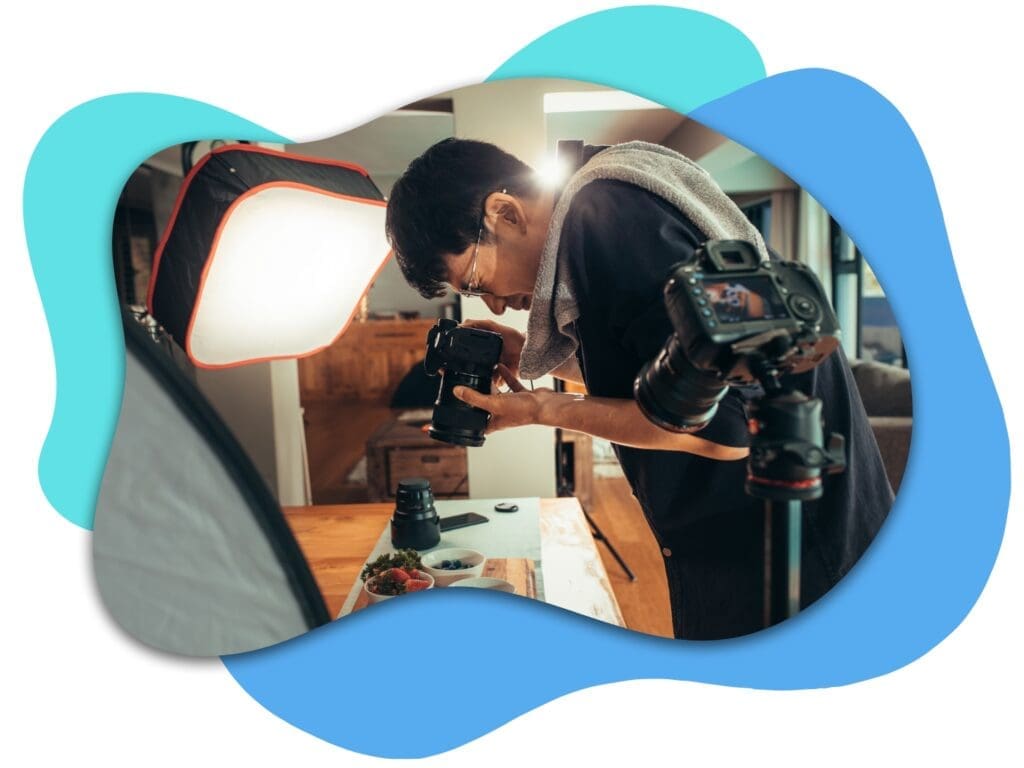Capture Dreams & Build a Business
Have you ever dreamt of turning your passion for photography into a thriving business? Imagine the freedom of working from your home studio, wielding your camera to create stunning images, and building a successful career around your artistic vision. The rise of online platforms and the growing demand for high-quality photography make it more achievable than ever to start a photography studio online.
A Story of Success
Sarah, a former accountant who traded spreadsheets for shutter speeds. Frustrated by the corporate grind, Sarah leveraged her love of photography and her spare bedroom to launch “Little Light Studios,” a home-based photography business specializing in capturing precious newborn moments. Through a captivating website, stunning social media posts, and exceptional client service, Sarah’s business boomed. Now, she photographs newborns full-time, setting her own schedule, and doing what she loves most.

What is a Home Photography Studio?
A home photography studio is exactly what it sounds like: a dedicated workspace within your home equipped for professional photography sessions. This doesn’t require a massive renovation – a spare bedroom, garage, or even a well-lit corner can be transformed with the right equipment and creative thinking.
Benefits of a Home Studio
There are numerous advantages to starting your photography journey with a home studio;
- Flexibility: Set your own hours, create a work-life balance that suits you, and schedule client sessions around your life, not the other way around.
- Lower Overhead Costs: Save on expensive studio rentals, allowing you to invest more in essential equipment and marketing efforts.
- Creative Control: Design your studio space to reflect your unique style and cater to your chosen photography niche.
- Comfortable Environment: Many clients, particularly families with young children, appreciate the relaxed and familiar atmosphere a home studio provides.
Is it Right for You? Assessing Your Dreams
Before diving in, consider your lifestyle and goals.
A home studio thrives with dedication and organization. Can you carve out dedicated space and time for your business? Are you comfortable working independently and managing all aspects of your business, from marketing to client communication?
Building Your Brand in the Digital Age
The internet has revolutionized the photography industry.
Online platforms like websites and social media allow you to showcase your work, connect with potential clients worldwide, and build a strong brand identity for your home studio.
This guide will equip you with the essential steps to turn your passion for photography into a thriving online business.
Finding Your Niche
Imagine walking into a bustling art gallery, not overwhelmed by a chaotic mix of styles, but drawn to a specific section overflowing with vibrant landscapes. This targeted approach is the essence of finding your niche in photography.
By specializing in a specific area, you can attract a dedicated clientele, refine your skills, and become a recognized expert within your chosen field.
Passion & Expertise
The foundation of a successful niche lies in the sweet spot between your passion and your expertise.
What ignites your creative fire?
Do you adore capturing the playful innocence of childhood, the timeless elegance of weddings, or the intricate details of product photography?
Once you identify your passion, assess your existing skills and areas where you can further develop your expertise.
Understanding Your Audience
Don’t operate in a vacuum!
Dive into market research to understand what types of photography are in high demand and identify any potential gaps.
Browse online photography communities, popular social media platforms like Pinterest and Instagram, and explore photography marketplaces like Etsy to see what styles resonate with audiences and what niches seem under-served.
What Makes You Unique?
Every photographer has a unique voice and perspective.
What sets you apart from the crowd?
Do you have a knack for capturing candid moments with a photojournalistic approach?
Perhaps you excel at creating whimsical and dreamlike portraits. Identifying your strengths allows you to refine your niche and cater to clients seeking a specific style.

Examples of Profitable Niches
The world of photography offers a vast array of profitable niches. Here are a few examples to spark your imagination;
- Newborn Photography: Capture the fleeting moments of a baby’s arrival with tender and heartwarming photos.
- Product Photography: Showcase products in a visually appealing way to boost online sales for businesses.
- Family Photography: Document families’ milestones and create lasting memories through authentic and joyful portraits.
- Real Estate Photography: Entice potential buyers with captivating images that showcase properties at their best.
- Event Photography: Capture the excitement and energy of weddings, parties, or corporate events.
Remember, this is not an exhaustive list. The key is to find a niche that aligns with your passion, skills, and the current market demand.
Building Your Home Studio
Now that you’ve honed in on your niche, it’s time to transform your dedicated space into a functional and inspiring home studio. While fancy equipment and a sprawling studio might seem ideal, creating professional-looking images starts with the essentials and a touch of creative resourcefulness.

Essential Equipment
- Camera: Your trusty camera is the heart of your studio. A DSLR or mirrorless camera with interchangeable lenses offers superior control and image quality compared to smartphone cameras.
- Lenses: Invest in a versatile lens kit, ideally including a zoom lens for various portrait and product shots and a prime lens for capturing stunning bokeh (background blur) in close-up portraits.
- Tripod: A sturdy tripod ensures camera stability for sharp images, especially during long exposures or when using lower light settings.
Budget-Friendly Tips
Building a home studio doesn’t require breaking the bank. Consider starting with a good quality used camera and lens, readily available through reputable online retailers.
Many photography schools or studios offer equipment rentals, allowing you to test specific lenses or lighting setups before committing to a purchase.
Creating Your Backdrop
The backdrop is the canvas for your photographic storytelling. Depending on your chosen niche, explore various options;
- Fabric Backdrops: Available in a variety of colors and textures, fabric backdrops offer a wrinkle-resistant and portable solution. Popular choices include muslin and canvas.
- Vinyl Backdrops: Vinyl backdrops provide a wider range of creative options, mimicking natural settings like brick walls or serene landscapes. They are typically more durable than fabric backdrops.
- Painted Walls: A dedicated studio space allows for painting one or more walls with specific colors or patterns to create a permanent backdrop.
Lighting Essentials
Lighting plays a crucial role in creating professional-quality images. Natural light is ideal, but not always readily available. Consider investing in;
- Speedlights: Compact and portable, speedlights offer a good introduction to artificial lighting. They can be mounted on your camera or used off-camera for creative lighting effects.
- Softboxes: These diffusers soften the harsh light from speedlights, resulting in more flattering and natural-looking portraits.
- Continuous Lighting: For video work or situations requiring constant light, consider continuous lighting options like soft light panels or LED lights.
Mastering the Craft
Even the most captivating studio space pales in comparison to the power of honed photography skills. This section equips you with the foundational knowledge to translate your creative vision into stunning images that leave a lasting impression.
Photography Basics
- Composition: Learn the essential rules of composition, like the rule of thirds, leading lines, and negative space, to create visually balanced and engaging photographs.
- Lighting: Master the art of lighting. Experiment with natural light, understand the properties of artificial light, and explore lighting techniques like backlighting or sidelighting to achieve different moods and effects.
- Exposure: Exposure, the balance between light and darkness in a photograph, is crucial. Learn how to use aperture, shutter speed, and ISO settings to achieve optimal exposure in various lighting conditions.
Editing Essentials
While your camera captures the raw image, editing software like Adobe Photoshop or GIMP empowers you to transform them into polished masterpieces.
Focus on mastering basic editing techniques like cropping, adjusting brightness and contrast, and color correction. Numerous online tutorials and courses can guide you through the editing process.
Practice Makes Perfect
There’s no substitute for practice. Schedule regular photo shoots, experiment with different lighting setups and poses, and don’t be afraid to step outside your comfort zone.
Volunteer your photography skills for local events or offer free mini-shoots to friends and family in exchange for feedback. The more you shoot, the more you’ll refine your skills and develop your unique photographic style.
Online Learning Resources
The internet offers a wealth of free and paid photography learning resources.
Explore online photography courses, tutorials, and blogs to deepen your understanding of specific shooting techniques, editing software, or lighting setups. Many professional photographers share valuable insights and tips through engaging YouTube channels or social media platforms.

Building Your Online Presence
In today’s digital age, your online presence is your storefront window. It’s where potential clients discover your work, learn about your unique offerings, and ultimately decide to book your services.
Here’s how to craft a compelling online presence that attracts your dream clients.
Crafting a Compelling Brand
Your brand is your story. What sets you apart from other home studio photographers?
Develop a clear brand identity that reflects your personality, niche expertise, and artistic vision. This translates into your website design, logo, and how you present yourself on social media platforms.
Website Essentials
Your website is your online home base. Invest in a user-friendly and visually appealing website showcasing your best work. Here’s what to include;
- Captivating Portfolio: Feature high-quality images that represent your chosen niche and highlight your skills.
- About Me Section: Introduce yourself and your photography journey, showcasing your personality and passion for the craft.
- Services & Pricing: Clearly outline the photography services you offer and your pricing structure. Package your services creatively to cater to different client needs and budgets.
- Contact Information: Make it easy for potential clients to reach you with a clear contact form, email address, and links to your social media profiles.
The Power of Social Media
If me, I would focus on social media even before building the website. Social media has a larger reach due to their algorithms and have targeted audiences. This would then be used as a funnel to your website for people to make bookings or order prints.
Social media platforms like Instagram, Facebook, and Pinterest are powerful tools for connecting with potential clients. Here’s how to leverage them effectively;
- Choose Your Platforms Wisely: Focus on platforms popular with your target audience. For example, showcase family portraits on Facebook and product photography on Instagram.
- Post Consistently: Regularly share captivating photos, behind-the-scenes glimpses, and engaging content relevant to your niche.
- Run Targeted Ads: Consider paid advertising on social media to reach a wider audience and attract your ideal clients.
- Engage with Your Community: Respond to comments and messages promptly, participate in relevant online communities, and build relationships with potential clients.
Content Marketing Magic
Don’t just rely on beautiful photos – create valuable content that educates and inspires your audience. This could include;
- Blog Posts: Share photography tips, showcase client testimonials, or offer behind-the-scenes insights into your creative process.
- Free Mini-Guides: Offer downloadable guides on basic photography techniques or choosing the right photographer for specific needs.
- YouTube Videos: Create tutorials on lighting setups, editing techniques, or posing tips to showcase your expertise and attract potential clients.
SEO for Photographers
Search Engine Optimization (SEO) helps potential clients find you online.
Optimize your website content and social media profiles with relevant keywords related to your photography niche. Utilize location-based keywords to attract clients in your local area.
Legal Considerations & Business Basics
Before diving headfirst into booking clients, ensure your home studio operates within the legal and financial framework. Understanding essential legalities and establishing sound business practices will protect you and position your studio for success.
Legalities: Knowing the Rules
Local regulations regarding home-based businesses can vary. Research and obtain any necessary licenses or permits required for operating a photography studio from your home.
Contact your local government or business development office for specific requirements in your area.
Taxes & Business Structure
Consult with a tax professional to determine the optimal business structure for your home studio.
Common options include sole proprietorship, offering simplicity, or Limited Liability Company (LLC), providing personal asset protection. Each structure has different tax implications, so understanding these is crucial.
Insurance Protection
Investing in business insurance is highly recommended.
General liability insurance protects you against potential claims of property damage or bodily injury during client sessions. Consider equipment insurance to safeguard your valuable camera gear.
Pricing Strategies
Setting competitive yet profitable pricing requires research.
Explore what other home studio photographers in your niche charge, considering factors like experience, location, and the level of service offered.
Don’t undervalue your skills – your photography expertise deserves fair compensation.

Booking Clients & Delivering Excellence
Landing your first client is a thrilling moment, but the journey doesn’t stop there.
Exceptional communication, clear contracts, and a commitment to exceeding client expectations are the cornerstones of building trust and fostering long-term client relationships.
Client Communication
Communication is key from the very first inquiry.
Respond promptly to potential clients, answer their questions thoroughly, and clarify any expectations. Listen actively to their needs and tailor your packages to their specific desires.
Setting Expectations
A photography contract protects both you and your client.
This document outlines the services offered, session details (date, time, location), pricing, cancellation policy, and payment terms.
Consider using online legal service platforms or consulting a lawyer to ensure your contract is comprehensive and legally sound.
Streamlining Your Workflow
Invest in a user-friendly online booking system. This allows clients to easily schedule sessions, manage appointments, and make payments securely.
Maintaining a well-organized calendar is crucial for avoiding scheduling conflicts and ensuring a smooth workflow.
We recommend you try Calendly for your bookings.
Focus on The Client Experience
From the initial booking to the final image delivery, prioritize client satisfaction.
Create a relaxed and enjoyable atmosphere during photo sessions. Be prepared, professional, and open to collaboration. Deliver high-quality images within the agreed timeframe, and consider offering sneak peeks or bonus edits to further delight your clients.
Positive word-of-mouth recommendations are powerful marketing tools – strive to exceed expectations at every touchpoint.

Growing Your Business
Your home studio is up and running, you’re capturing stunning images, and satisfied clients are singing your praises. But there’s always room for growth!
Here’s how to take your home photography business to the next level and attract even more success.
Networking & Collaboration
Networking with other photographers and businesses can be incredibly beneficial. Connect with fellow photographers at local workshops or online communities.
Collaborate on creative projects, offer referral programs with complementary businesses like stylists or makeup artists, and expand your reach through strategic partnerships.
The Power of Testimonials
Don’t be shy about showcasing glowing client testimonials on your website and social media platforms.
Positive feedback from satisfied clients adds credibility and builds trust with potential customers. Encourage clients to leave reviews on online platforms and social media to further solidify your reputation.
Advanced Techniques & Education
The world of photography is constantly evolving.
Invest in your professional development by taking online courses or attending workshops to learn advanced editing techniques, explore new lighting setups, or master specific photography styles. Staying ahead of the curve allows you to offer even more valuable services to your clients.
Upselling & Expanding Services
As your business grows, consider expanding your service offerings. This could include;
- Selling Prints & Products: Offer high-quality prints, albums, or digital downloads of your photos for clients to cherish their memories.
- Editing Services: Provide professional editing services for other photographers or businesses.
- Workshops & Tutorials: Share your expertise by offering photography workshops or online tutorials.
By diversifying your income streams, you can create a more sustainable and profitable business model for your home photography studio.
Capture Success & Live Your Photography Dream
Congratulations!
You’ve explored the essential steps for launching and running a thriving home photography studio. From finding your niche and mastering the craft to building a captivating online presence and nurturing client relationships, this guide equips you with the knowledge and resources to turn your passion into a rewarding career.
Remember the Key Ingredients
Keep these core principles in mind;
- Focus on Your Niche: Specialize in a specific area, honing your skills and attracting a dedicated clientele.
- Invest in Learning: Master the technical aspects of photography and continuously expand your knowledge base.
- Build Your Online Brand: Craft a professional website and leverage social media to showcase your work and connect with potential clients.
- Prioritize Client Satisfaction: Deliver exceptional service, exceed expectations, and cultivate long-lasting client relationships.
The Rewards of Passion
Building a successful home photography studio requires dedication and hard work, but the rewards are truly fulfilling.
Imagine the freedom of setting your own schedule, working from your creative space, and capturing moments that become cherished memories for your clients.
Your Journey Begins Now
The world of photography is boundless.
Embrace lifelong learning, explore new techniques, and constantly refine your artistic vision. Remember, the most successful journeys begin with a single step.
So grab your camera, unleash your creativity, and embark on your exciting home photography studio adventure.
